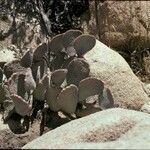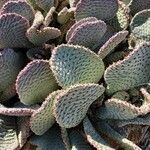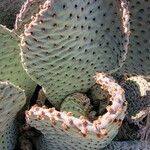Shrubs, forming clumps, 1-2(-3) segments tall, to 7-40 cm. Stem segments not disarticulating, blue-to yellow-green, sometimes tinged maroon-purple, flattened, spat-ulate to broadly obovate or subcircular, thick, 5-22(-35) × 2-13.5(-16) cm, nearly smooth, papillose to puberulent (rarely glabrous); areoles 4-16(-19) per diagonal row across midstem segment, circular to elliptic, 3-5 × 3 mm; wool white to tan, aging gray. Spines 0(-8) per areole, when present, usually in distal areoles, spreading, yellow, straight, acicular, 5-25 mm. Glochids numerous, nearly filling areoles, yellow to red-brown or dark brown, to 3 mm. Flowers: inner tepals pink to magenta throughout (rarely white), 25-40 mm; filaments red-magenta (rarely pale); anthers yellowish; style white to pink; stigma lobes white to cream. Fruits maturing tan, 20-40 × 15-23 mm, dry at maturity, puberulent, spineless (except in var. treleasei); umbilicus 5-12 mm deep; areoles 24-76. Seeds yellowish to tan, ± subspheric but angular, thick, 6.5-9 × 6.5-7 mm, sides smooth or bearing 1-3 depressions; girdle protruding to 1 mm.
More
A bush cactus. It grows about 1 m high. The joints are almost oval. They are bluish-green or pale red-green. They are 10-20 cm long. They have a velvety appearance. The spine spots are brownish. The have barbed bristles and one short spine. It flowers in the daytime. The flowers are reddish-purple. They are 6-8 cm long.
A subtropical plant. It needs a bright sunny position. It grows in dry conditions between 150-2,200 m above sea level. It needs a temperature above 7°C. It grows in alkaline soil. It suits hardiness zones 9-11.
More
Sandy or rocky soil with chipping in chaparral, woodlands, desert flats, plains, valleys, streams and hills generally in hot deserts; at elevations from 100-1,800 metres.




